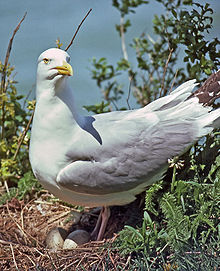
American Herring Gull
Larus smithsonianus
Weight
2 - 4 lbs ( 1 - 2 kg)
Height
24 - 26 inches ( 60 - 66 cm)
Regions
North America, South America
About American Herring Gull
The American Herring Gull or Smithsonian Gull (Larus smithsonianus) or (Larus argentatus smithsonianus) is a large gull which breeds in North America. It is often treated as a subspecies of the European Herring Gull (L. argentatus) but is now regarded as a separate species by some authorities.
Adults are white with gray back and wings, black wingtips with white spots, and pink legs. Immature birds are gray-brown and are darker and more uniform than European Herring Gulls with a dark tail.
It occurs in a variety of habitats including coasts, lakes, rivers and garbage dumps. Its broad diet includes invertebrates, fish, and many other items. It usually nests near water, laying around three eggs in a scrape on the ground.
The breeding range extends across the northern part of North America from central and southern Alaska to the Great Lakes and north-east coast of the USA south to North Carolina. It breeds over most of Canada apart from the southwest and Arctic regions.
Birds are present all year in southern Alaska, the Great Lakes and north-east USA but most birds winter to the south of the breeding range as far as Mexico with small numbers reaching Hawaii, Central America and the West Indies. Vagrants have reached Colombia and Venezuela and there is a report from Ecuador and another from Peru. The first European record was of a bird ringed in New Brunswick which was caught on a boat in Spanish waters in 1937 and there are have a number of additional records from Western Europe since 1990. The first British record was in 1994 in Cheshire.
It usually nests in colonies near water on coasts, islands, and cliffs. It also nests on rooftops in some cities. It feeds at sea and on beaches, mudflats, lakes, rivers, fields, and refuse dumps. It roosts in open areas close to feeding sites.
Hunting Techniques
Choice of hunting equipment
